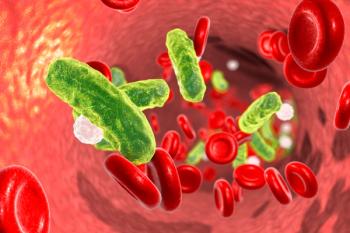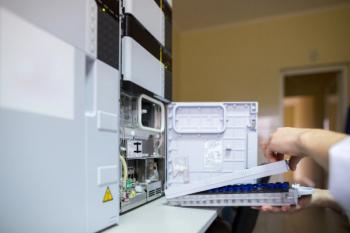
- LCGC Europe-11-01-2017
- Volume 30
- Issue 11
Capillary Electrophoresis: The Past, Present, and Future
Inspired by the work of Jorgenson and Lukacs, 30 years ago, the group of Richard Smith at Pacific Northwest National Laboratory in Washington (USA) reported the first online coupling of the microscale separation technique capillary electrophoresis (CE) to electrospray ionization (ESI) mass spectrometry (MS) using a sheath-liquid interface.
Inspired by the work of Jorgenson and Lukacs (1), 30 years ago, the group of Richard Smith at Pacific Northwest National Laboratory in Washington (USA) reported the first online coupling of the microscale separation technique capillary electrophoresis (CE) to electrospray ionization (ESI) mass spectrometry (MS) using a sheath-liquid interface (2). In this interfacing design, the sheath-liquid is provided co-axially to the end of the CE capillary as a terminal electrolyte reservoir to provide a closed electrical contact. In 1995, this interface became commercially available and since then has been considered the standard solution for coupling CE to MS. The introduction of the sheath-liquid interface expanded the role of CE in bioanalytical chemistry, notably for peptide and protein analysis. Although the sheath-liquid interface enabled seamless hyphenation to MS, the flow of the sheath-liquid is relatively high and therefore does not allow the use of CE–MS under nano-ESI conditions. Furthermore, the CE effluent is significantly diluted by the sheath-liquid, which further compromises detection sensitivity. In this context, the development of interfacing designs for the effective hyphenation of CE to MS has continued to be an active research area (3).
A key development 30 years ago was also the development of laser-induced fluorescence (LIF) detection for CE analyses by the research laboratories of Norman Dovichi and Edward Yeung (4,5). The utility of CE–LIF for the subattomole detection of amino acids was reported by the Dovichi group in 1988 in Science (5). CE–LIF emerged as a very useful analytical tool for the selective determination of derivatized (D- and L-)amino acids, especially with applications in the field of neuroscience for analyzing trace-level neurotransmitters in microdialysates and brain tissue homogenates. CE–LIF is also used as a powerful approach for N-glycan profiling of therapeutic glycoproteins (6).
Thirty years ago, the group of Barry Karger was the first to show the utility of CE, more specifically capillary gel electrophoresis (cGE), for DNA sequencing (7). By using replaceable linear polyacrylamide matrices, DNA sequencing of more than 1000 bases for each run could be achieved, and as a result of limited diffusion of oligonucleotides a separation efficiency of 10 million theoretical plates could be obtained with these CE columns using noncrosslinked linear polyacrylamide (8). Fluorescence detection played a key role in DNA sequencing using capillary array electrophoresis (CAC) (9).
Capillary gel electrophoresis, employed in array format and combined with fluorescence detection (FD), turned out to be the key technology for sequencing of the human genome. Genomics can actually be regarded as the killer application for this technology. Currently, cGE in conjunction with sodium-dodecyl sulfate (SDS), also known as CE–SDS, is used as one of the main tools in biopharmaceutical and academia for quantitative protein purity analysis of biologicals, particularly for monoclonal antibodies.
Going back to CE–MS, at this moment, various recently developed interfacing designs are available that allow CE to be combined with MS under nano-ESI conditions (10,11), that is, the inherently low flow-rate of CE is effectively used. The utility of these new CE–MS approaches has been demonstrated in metabolomics and (glyco)proteomics with very promising results. Given the excellent detection sensitivities that can be obtained, I especially foresee a key role for these technologies in addressing those biomedical problems intrinsically dealing with limited sample amounts, including chiral metabolic profiling of such samples. It should be noted, however, that these methods are still in their infancy for actual proteomics and metabolomics studies, which often involve the analysis of hundreds up to thousands of clinical samples. At this stage, only a selected number of research groups is assessing the performance of these approaches for bioanalysis and time will tell whether acceptable metrics (as required for biomedical and clinical studies) can be obtained, and whether these technologies will be taken over by other research groups and biopharmaceutical companies. Active support from vendors will be crucial in this challenging endeavour.
Overall, CE has become an established analytical tool in the clinical laboratory, forensic laboratory, and biopharmaceutical companies. In these areas, it is expected that developments in CE will particularly focus on further improving the throughput, that is, using narrower and shorter capillaries in array format and going from seconds instead of minutes for separation times. Also, the concept of using multiple injections in a single electrophoretic run will be further evaluated in these fields. Concerning CE–MS, some critical hurdles still need to be tackled before it is ready for actual clinical studies. This is particularly true when using new interfacing designs. Recent work in this area indicates that CE–MS is heading in the right direction (12–16).
Acknowledgements
Rawi Ramautar would like to acknowledge the financial support of the Veni grant scheme of the Netherlands Organization for Scientific Research (NWO Veni 722.013.008).
References
- J.W. Jorgenson and K.D. Lukacs, Anal. Chem.53, 1298–1302 (1981).
- R.D. Smith, C.J. Barinaga, and H.R. Udseth, Anal. Chem. 60, 1948–1952 (1988).
- P.W. Lindenburg, R. Haselberg, G. Rozing, and R. Ramautar, Chromatographia 78, 367–377 (2015).
- W.G. Kuhr and E.S. Yeung, Anal. Chem. 60, 1832–1834 (1988).
- Y.F. Cheng and N.J. Dovichi, Science 242, 562–564 (1988).
- M. Szigeti and A. Guttman, Methods Mol. Biol. 1503, 265–272 (2017).
- A.S. Cohen, D.R. Najarian, A. Paulus, A. Guttman, J.A. Smith, and B.L. Karger, Proc. Natl. Acad. Sci.85, 9660 (1989).
- E. Carrilho, M. Ruiz-Martinez, J. Berka, I. Smirnov, W. Goetzinger, F. Foret, A.W. Miller, D. Brady, and B.L. Karger, Anal. Chem.68, 3305–3313 (1996).
- X.C. Huang, M.A. Quesada, and R.A. Mathies, Anal. Chem.64, 2149–2154 (1992).
- M. Moini, Anal. Chem.79, 4241–4246 (2007).
- R. Wojcik, O.O. Dada, M. Sadilek, and N.J. Dovichi, Rapid Commun. Mass Spectrom.24, 2554–2560 (2010).
- C. Pontillo and H. Mischak, Clin. Kidney J.10, 192–201 (2017).
- F. Boizard, V. Brunchault, et al., Sci Rep. 6, 34453 (2016).
- C. Wenz, C. Barbas, et al., J. Sep. Sci.38, 3262–3270 (2015).
- A.N. Macedo, S. Mathiaparanam, L. Brick, K. Keenan, T. Gonska, L. Pedder, S. Hill, and P. Britz-McKibbin, ACS Cent Sci.3, 904–913 (2017).
- R. Ramautar, Adv. Clin. Chem. 74, 1–34 (2016).
Rawi Ramautar is a principal investigator in the Division of Systems Biomedicine and Pharmacology at the Leiden Academic Centre for Drug Research at Leiden University, in The Netherlands.
Articles in this issue
about 8 years ago
Hitting Thirtyabout 8 years ago
LC Column Technology: The State of the Artabout 8 years ago
GC: The State of the Artabout 8 years ago
LC Instrumentation: The State of the Artabout 8 years ago
Sample Preparation: The State of the Artabout 8 years ago
The Evolution of 3D Printingabout 8 years ago
The Past, Present, and Future of Multidimensional Gas ChromatographyNewsletter
Join the global community of analytical scientists who trust LCGC for insights on the latest techniques, trends, and expert solutions in chromatography.




